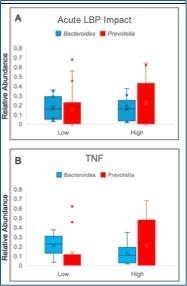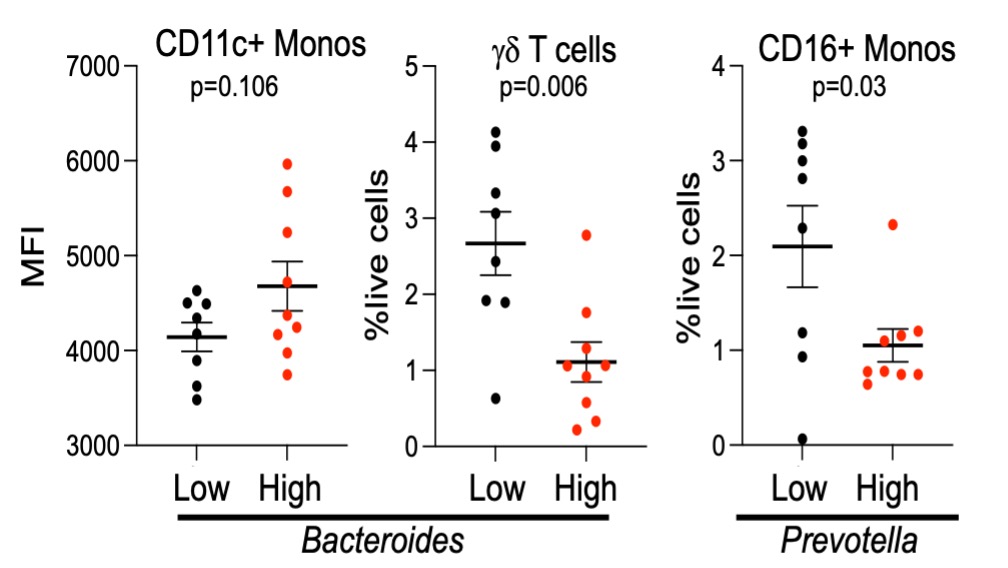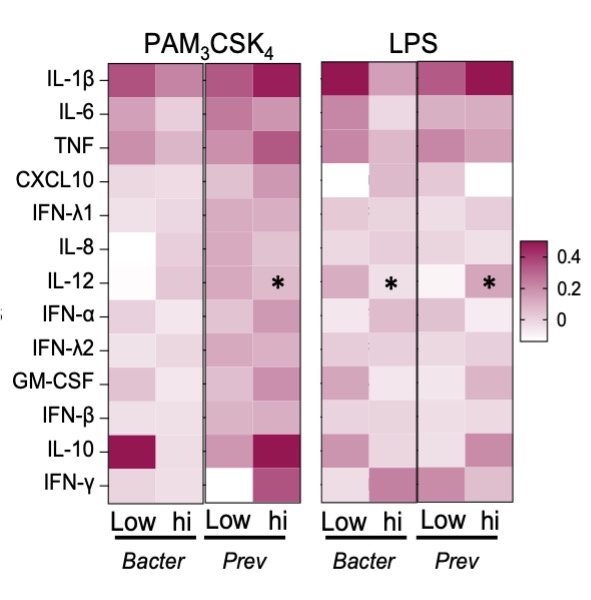Session Information
Date: Sunday, November 17, 2024
Title: Orthopedics, Low Back Pain, & Rehabilitation – ACR/ARP Poster
Session Type: Poster Session B
Session Time: 10:30AM-12:30PM
Background/Purpose: Low Back Pain (LBP) is highly prevalent, with up to 25% of individuals experiencing LBP each year, with as many as 32% transitioning to chronic LBP. Microbiome (MB) profiles, including the ratio of Prevotella to Bacteroides, can influence systemic inflammation, potentially affecting pain perception. Examining MB and immunological profiles in acute LBP may elucidate mechanisms contributing to risk of chronic LBP. The purpose of this study was to determine if MB profiles differed based on pain severity, immune cell status and functionality, and inflammatory biomarkers in individuals with acute LBP.
Methods: Community-based participants with acute LBP (pain < 4 weeks with no pain in the prior 30 days), were recruited.. At the baseline visit, pain questionnaires and blood samples were collected. Participants were asked to collect and return a fecal sample within 1 week of their baseline visit. Participants were classified into acute LBP impact categories with more frequent (most or everyday) and intense (>30 / 100 self-reported) LBP considered high impact. Illumina amplicon sequencing of the 4th variable region of the 16S rRNA was performed on fecal microbiome samples, and plasma cytokine analysis was completed to measure Tumor Necrosis Factor (TNF) levels, a proinflammatory cytokine secreted by immune cells. MB profiles were compared using nonparametric methods based on LBP impact (high vs low) and relative TNF levels (high vs low, based on the sample median). Peripheral blood mononuclear cell (PBMC) phenotyping and stimulation assays were used to test the association between innate and adaptive immune status versus the relative abundance of bacteria using parametric methods.
Results: N=19 participants (mean age 49.3 years [range 24-74], 58% identified as Non-Hispanic White) completed a baseline visit and returned fecal MB samples. Seven participants were classified as having high impact acute LBP, indicating more frequent and more severe pain. A non-significant trend of higher relative abundance of Prevotella in participants with high-impact acute LBP was found (mean 0.215 vs 0.153; W=51.5, p=0.44) (Figure 1A). In participants with higher plasma TNF levels, trends of higher abundance of Prevotella (mean 0.213 vs 0.135; W = 48, p = 0.50) and lower abundance of Bacteroides (mean 0.137 vs 0.216; W=25, p=0.20) were found (Figure 1B). In PBMC (n=17), Prevotella and Bacteroides load was significantly associated with gd T cells, CD16+ monocytes (Figure 2), and LPS-mediated induction of the pro-inflammatory cytokine IL-12 (Figure 3).
Conclusion: Microbiome profiles may differ in individuals with acute LBP based on inflammatory status and severity of LBP, though larger sample sizes are needed. Understanding differences in MB profiles may lead to alternative treatment options and early identification of individuals at risk for poor long-term prognosis for LBP.
To cite this abstract in AMA style:
Fillipo R, Brown M, Arnold J, Burke C, Danyluk S, Seebeck K, Goode A. Differences in Microbiome Profiles Based on Pain Severity and Inflammatory Biomarkers in Acute Low Back Pain [abstract]. Arthritis Rheumatol. 2024; 76 (suppl 9). https://acrabstracts.org/abstract/differences-in-microbiome-profiles-based-on-pain-severity-and-inflammatory-biomarkers-in-acute-low-back-pain/. Accessed .« Back to ACR Convergence 2024
ACR Meeting Abstracts - https://acrabstracts.org/abstract/differences-in-microbiome-profiles-based-on-pain-severity-and-inflammatory-biomarkers-in-acute-low-back-pain/



